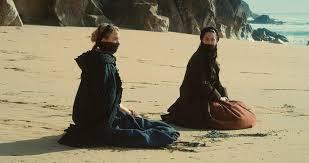Format: Streaming video from Hulu+ on rockin’ flatscreen.

Every year when the latest version of the 1001 Movies list comes out, I decide which of the movies I haven’t seen is going to be the one I save for last. This year, the choice was clearly going to be Portrait of a Lady on Fire (or Portrait de la jeune fille en feu if you prefer the original French). On Letterboxd, 45% of the ratings are five stars, and more than 85% are four stars or more. It was very much a case of saving the best for last.
Sometimes I don’t like to show my hand, but I’m going to for this. Portrait of a Lady on Fire is everything I want in a romance film. It’s beautifully filmed, filled with lingering and tender shots, and best of all, tragic. I’m not apologetic about this—tragic romances are better specifically because they are tragic romances. It’s the yearning that makes them work, that sense of living a whole life in a few days that makes them beautiful. And that, flatly, is Portrait of a Lady on Fire.
Here’s the quick and dirty plot summary. A woman named Marianne (Noemie Merlant) is hired to paint the wedding portrait of a woman named Heloise (Adele Haenel). Heloise is not happy to be betrothed and hasn’t met the man she is marrying. In fact, she is a substitute bride. The original bride was her sister, who possibly committed suicide to avoid the marriage. All that is known is that she fell off a high cliff, but according to the servant who was walking with her (Luana Bajarmi), never cried out.
We learn from Heloise’s mother (Valeria Golino) that one painter has already tried and failed to paint Heloise’s portrait. He failed because Heloise refused to sit for him and never showed him her face. The trick this time is to claim that Marianne is there as a companion—she paints in private from memory. Eventually, Marianne finishes the portrait, confesses her role, and shows the painting to Heloise, who doesn’t like it. Angry, Marianne destroys it and promises to start over. Heloise agrees to pose for this one, and as her mother needs to be gone for several days, the agreement is essentially made to paint the portrait while she is gone.
What proceeds from this, then, is the romance. Marianne and Heloise have a brief and tender affaire de couer. Then with the portrait completed and Heloise’s mother returned Marianne leaves, her job complete. A brief coda shows us how Marianne dealt in some small way with the end of their meeting.
Portrait of a Lady on Fire is very much a film made for the female gaze. In my head at least, there seems like a kind of connection between this film and Blue is the Warmest Color. Perhaps it’s the French language (and not merely the lesbian relationship), but more likely it’s the intensity of the relationship. Blue is a beautiful film, but the sex scenes are brutal, almost pornographic. That’s not the case with Portrait, where the sex is almost an afterthought. We get a chaste kiss or two (and a not-so-chaste few) and some post-coital nudity that feels almost innocent, and that’s it. The focus here isn’t on the sex or on the passion that drives it, but the genuine relationship between the two.
The other film that this reminds me of is In the Mood for Love, which remains one of the most beautiful and tragic romances I have ever seen. The ending of Portrait of a Lady on Fire evokes this in many ways. Again, it’s a tragic yearning, a terrible loss coupled with a beautiful memory that makes the loss that much more tragic. It’s a memory that hurts at the same time it consoles.
What makes Portrait of a Lady on Fire truly work, though, is just how long it lingers on shots. This is a film that wants us to study the faces of the people on screen. Shots linger, often longer than feels comfortable, but with purpose. Celine Sciamma wants us to look at these women as women, not as objects to catch our attention. There are no needless cuts here, nothing jarring.
For me, the key scene is the bonfire in the middle. A collection of women have gathered and begin singing. This is the first time we see something like desire, admiration, and love pass between Marianne and Heloise. It’s also where Heloise’s dress briefly catches on fire and gives us, at least in part, the title of the film and the explanation for the opening sequence. And again, the shots are lingering and loving rather than created to force our attention.
There’s not a lot to complain about here. Had France decided to put this in the running for Best International Feature in 2019, Parasite might have had a run for its money. It’s that good.
Why to watch Portrait of a Lady on Fire: It’s close to perfect.
Why not to watch: If you’re homophobic... p>
